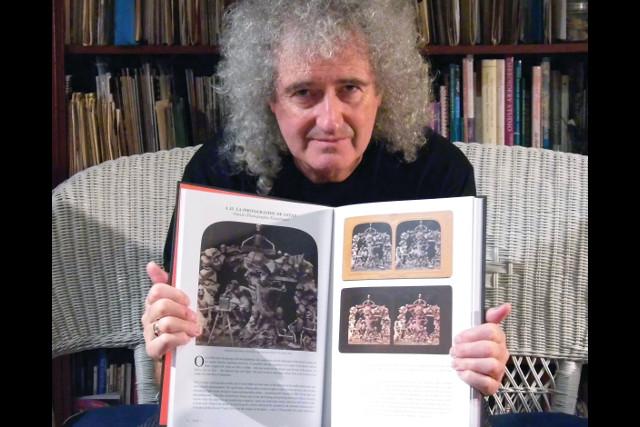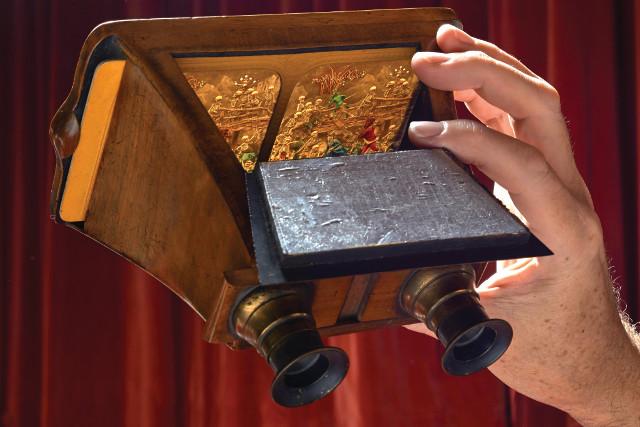E&T MAGAZINE
20 January 2014 by Nick Smith

Brian May showing “Diableries: Stereoscopic Adventures In Hell” book Brian May might well be best known as a virtuoso musician of world renown, and most of us will be aware that his doctorate is in astrophysics, but he is also a world expert on early stereographic photography technology.
As has happened so many times for this legendary guitarist as the lights dim, the crowd settles into impatient and yet hushed expectation. Brian May saunters onto the stage followed by two colleagues. He takes to the lectern flanked by Denis Pellerin and Paula Fleming, makes a joke or two, and introduces the subject of this evening’s lecture: 19th century stereoscopic photography. As odd as it might seem, May and his co-authors are launching a new book on historic 3D imagery at the British Library to a select band of a few hundred enthusiasts.
‘Diableries: Stereoscopic Adventures in Hell’ is May’s second publication on what is now an all-but forgotten art form (his first was his rather bucolic ‘A Village Lost and Found’, which celebrated the work of British stereographic pioneer TR Williams). “It’s been a dream of mine for decades to bring stereo photography to London,” he informs the audience. For a man who has lived under the spotlight of soaring international success as a musician for most of his adult life, this might at first glance appear something of a modest dream. But, as the curiously gothic event progresses – it was held on the eve of Halloween – what becomes clear is that May is deadly serious, and his dream could well be more accurately described as an obsession.
Speaking with May a few days after the British Library event, he tells me how stereographic projection, or stereoscopy, is the technical process by which 3D images are created in the brain as a result of the fusion of almost identical images that have been marginally offset and viewed through a binocular instrument. The technology has been around since the dawn of photographic time, with the first sets of experimental stereographic plates produced in the 1840s.
For the Victorians, crowding around the stereo viewer was a wildly popular form of entertainment that May compares with modern television. Today, the card sets that go with the original viewers are hard to come by, but if you know where to look you’ll find them on subjects such as early geographical expeditions to Greenland or North America, or even quaint villages in Oxfordshire. But May’s new book is about a collection of card sets that have been dubbed the ‘diableries’ (or, ‘devilments’), and they are pretty diabolical.
“Stereoscopic images are by their very nature astounding because they have incredible dept. The compositions are stunning, not just because the eyes light up, jewellery glistens and lanterns glow. We’re looking at a whole parallel reality populated by skeletons getting up to all kinds of mischief. Add to that the political satire that is embedded in these tableaux, and you have something very special indeed.”

And spooky. There are devils and dervishes everywhere – even the book’s cover has a gold embossed flying demon playing a rather diabolical looking trumpet stamped on it. The Victorians loved spooky stuff.
Early obsessions
May says that his interest in stereoscopy started when “it reached out and grabbed” him as a kid.
“I was very inquisitive and I used to lie under the covers of my bed with’ one eye sticking out, pondering why my brain was receiving two different images. And this led to a curiosity in that direction.”
May recalls how in his youth the VistaScreen cards that came with Weetabix breakfast cereal fascinated him. You needed a viewer, but May worked out how to look at them in ‘free-view’ by either defocusing or crossing his eyes. But you could also (and he did) send off for a stereoscope that would set you back one shilling and sixpence (7.5p) in the form of a Postal Order.
“I figured out very quickly what they were doing to achieve 3D images, and that fascinated me, as it has done ever since. It’s such a simple principle, and yet no-one can tell you physiologically what’s going on in your brain when it puts the two images together to make a stereoscopic map of the world in your head.”
May soon became aware that stereoscopic imaging was one of the earliest forms of photography,
“and I discovered that all the pioneers of the technique were not simply technologists, but also artists. And I think that’s the great Victorian spirit. There’s no real hard dividing line between art and science. And that’s the way I am too. I think great art should be married to great science, because that’s when great things happen”.
The images themselves take the form of two treated photographs printed on tissue and mounted onto card frames; the treatment often being hand tinting, or the addition of coloured gels. May recalls finding some in junk shops as a young man, sparking a 40-year obsession with stereoscopy.
“You’ve got to remember that the Victorians had no phones or films. So these images really were the only window into the world. You’ll find cards dealing with every topic under the sun, but we chose the diableries to channel the technology into the 21st century.”
May says that if you want to put a precise date on the origin of stereoscopic portrayal of photographic images you need to go back to 1838, when the extraordinary English inventor Sir Charles Wheatstone first described ‘stereopsis’. This led to him receiving the Royal Medal of the Royal Society in 1840. But others were working along similar lines, including David Brewster and a certain Mr Eliot, a mathematics teacher from Edinburgh.
“This was exactly the time, when Fox Talbot was discovering his process in England (calotype), and Louis Daguerre was discovering his in France (daguerrotype).”
As is so often the case in technology, competition bred innovation. The race was on, and stereoscopic photography was born. READ more of interview HERE